For a few words about my
reviewing process and preferences, please see the introduction to
Music Reviews No. 36.
Introducing Il'ya Murometz,
“complete and uncut,” just as Reinhold Glière (1875-1956) wished you to
hear his symphony about the mythical marvel named Murometz. Behold 72
minutes of seductive bombast about an innocent Russian superhero of
enormous physical strength who fought evil, defended the simple folk,
spoke up to authority, and first waved his sword a good 1000 years before
Clark Kent shed his garb in a phone booth. If in the end his musical
representation doesn't have much substance, it nonetheless showcases him
so spectacularly attired in Telarc high-resolution sound that even the
most jaded will find themselves seduced by the glitz.
Glière, who publicly tutored students as professor at
the Moscow Conservatory while privately teaching the young Sergei
Prokoviev, was anything but a musical revolutionary. Considered the bearer
of the classical tradition both before and after the Communist revolution,
his nationalistic works were praised and studied in the USSR as examples
of a successful union between Eastern folklore and central European form.
In no danger of condemnation by Stalin, he was a member of many official
committees and was lauded as a People's Artist of the USSR. If his
well-know ballets such as The Red Poppy
(1927) and Taras Bulba
(1952), and his oft-played
“Hymn for the Great City” excerpted from his ballet The Bronze
Horseman (1949), and his numerous
works in other mediums in the end fail to reveal an individual voice, they
nonetheless contain enough rousing music to provide a classical evening's
alternative to the formulaic melodies of Madonna, Britney Spears and crew.
Il'ya Murometz was written between
1909 and 1911. An attempt to create a picturesque nationalistic epic, its
programmatic content seems more than coincidentally reminiscent of the
Romantic tone poems of Richard Strauss with a little Wagner, Borodin, and
Glazunov thrown in. The first movement, entitled “Wandering Pilgrims:
Il'ya Murometz and Svyaatogor,” introduces our hero. The son of a peasant,
Il'ya spends his first thirty years immobile, warming himself atop a
household stove until two ancient holy men get him off his tail by
predicting that he will become a powerful knight errant (bogatyr). When
Il'ya inherits the knight errant Svyatogor's powers, he mounts his mighty
steed, leaping over rivers and lakes. As his horse's tail sweeps away
whole cities as it passes, the music builds to
climaxes impressive enough to replace
ennui with wonder.
The 20-minute second movement andante, “Il'ya
Murometz and Solovei the Brigand,” offers much beauty with its orchestral
birdcalls (no Messaien dissonance here), mock animal cries, and sensual
portrayal of Murometz's seduction by the daughters of the supernatural
Solovei. If these gals can't build up the erotic charge of Strauss'
Salome, and the music's exoticism can't touch that of the French
impressionists, this movement nonetheless contains much undeniable beauty.
Unless your ancient Russian blood has already been
set aboil, you probably don't give a damn about the stories that inspire
Glière's third and fourth movements. Suffice it to say that the third
offers lots of wondrous excitement, while the tremendous triumph
communicated in the fourth's portrayal of Murometz's heroic deeds will
shake the rafters and drive evil spirits from your door. You may not
remember any of the tunes, but you'll undoubtedly mutter “wow” as you move
on to the ten o'clock news. This disc sounds fabulous in a good
two-channel set-up; in superior SACD format, and especially in surround
sound, it should provide a satisfying sonic alternative to another home
theater evening of gut-shaking brutality and gratuitous violence.

|
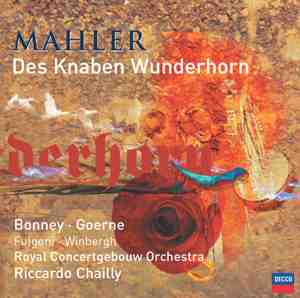 |
|
Mahler: Des Knaben Wunderhorn (The Youth's Magic Horn)
Bonney, Goerne
Royal Concertgebouw Orchestra, Chailly
Decca 2894673482
|
|
0 |
5 |
|
Performance |
 |
|
Sonics |
 |
|
Having recently interviewed baritone Matthias Goerne
in conjunction with his April Boston Symphony Orchestra performance of
eight songs from Gustav Mahler's Des Knaben Wunderhorn
orchestral song cycle [see the
Secrets archives], it is most
gratifying to discover him delivering Mahler with the same mesmerizing
sensitivity and vocal beauty that he brought to his recent recording of
Franz Schubert's Die schöne Müllerin.
And while the baritone's extremely slow tempi for some of the Schubert
songs have wowed some critics while dismaying others, few will question
that his Mahler interpretations are well nigh ideal.
Des Knaben Wunderhorn
was originally the title of a large
collaborative collection of poems written in German folk style by Achim
von Arnim and Clemens Brentano. Published in 1805 and 1808, the poems
first came to Mahler's attention in the early or mid 1880's, when he was
in his early or mid twenties. From 1888 to 1902, he wrote no less than
two-and-a-half volumes of songs inspired by the collection. So important
were the Wunderhorn poems
to his output that the song “Urlicht” (Primeval Light) became the fourth
movement of his Symphony No. 2, “Des Antonius von Padua Fischpredigt” (St.
Anthony of Padua Preaches to the Fish” served as the basis of its third
movement scherzo, and “Das himmlische Leben” (The Heavenly Life) became
the final movement of his Symphony No. 4.
According to Goerne, some of the Wunderhorn
songs were an attempt on Mahler's part to criticize the growing militarism
in Europe. Unfortunately, the baritone asserts, “Mahler's creation was not
strong enough. It was impossible in this period to make the kind of
anti-war criticism in music that was later possible for Berg, Schoenberg,
Eisler, Weill and Brecht… The words are incredible, but in the end, the
climax of the harmonies is so strong that everyone forgets what you are
telling them. The settings are so beautiful musically that they kill the
effect of the texts.”
Be that as it may, few vocal lovers will miss the
bite of the line “I can and will not be merry!” with which baritone and
orchestra launch the opening “Der Schildwache Nachtlied” (The Sentinel's
Night Song). Here, as in many of the Wunderhorn
songs based on a poetic dialogue between “He” and “She,” Goerne sings both
parts, balancing the manly thrust of “his” martial tone with a gorgeous
softening on “her” final sustained high note.
Soprano Barbara Bonney sings the jolly second song,
“Wer hat dies Liedlein erdacht?” (Who made up this ditty?) plus four
others. The choice of a soprano rather than mezzo to sing all but one of
the songs here assigned to female voice is certainly valid – soprano Lucia
Popp sings on recordings by Bernstein (his digital remake) and Tennstedt,
and Jessye Norman does the honors for Haitink -- but the energy Bonney
brings to the cycle is less satisfying than that of lustrous mezzo Christa
Ludwig (Bernstein) or Anne Sophie von Otter (Abbado).
Bonney certainly knows how to negotiate her low
notes, and to lighten her voice to lovely effect on mids and highs.
Marvelous in “Wo die schönen Trompeten blasen” (When the shining trumpets
are blasting), which she sings raptly with moving subtlety and care, she
just misses the mark elsewhere. A case in point is the glorious extended
vocal movement that concludes Mahler's Fourth Symphony. Bonney's
interpretation of this child's view of heavenly paradise swings between
welcome naïve sweetness and inappropriate maturity, as though she isn't
exactly sure of whom she is. (Listen to the young Kathleen Battle for an
ideal performance of this movement). There's certainly much to admire, but
far less to cherish.
No such case with Goerne. The man is brilliant. With
a voice alternately virile and achingly tender, he gifts Mahler's creation
with the steady flow of beauty it deserves. Chailly provides fine,
transparent accompaniment, and mezzo Sara Fulgoni and tenor Gosta Winbergh
do well with the one song each assigned to them. But ultimately it's
Goerne's show, and Mahler is all the better for it.

|
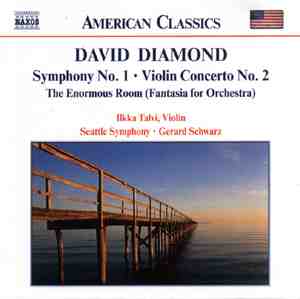
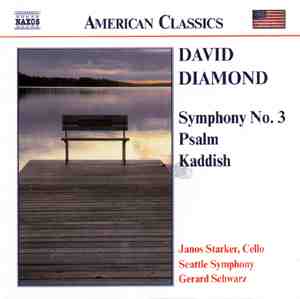 |
|
David Diamond: Symphony No. 1, Violin Concerto
No. 2, and The Enormous Room
Fantasia for Orchestra
Seattle
Symphony, Gerard Schwarz
Naxos 8.559157
David Diamond: Psalm,
Kaddish for Cello and
Orchestra (1987), Symphony No. 3
Seattle
Symphony, Gerard Schwarz
Naxos 8.559157
|
|
0 |
5 |
|
Performance |
 |
|
Sonics |
 |
|
SPOTLIGHT ON DAVID DIAMOND
One of the more prolific American composers of the
last century, David Diamond turned 88 on July 9. Although he has never
achieved the mass popularity and acceptance of such well-known 20th
century American compatriots as Samuel Barber, Aaron Copland, and Leonard
Bernstein he has created an impressive body of finely crafted work whose
tuneful romanticism and ruminative feel continue to win converts.
Bargain label Naxos has recently released two discs
of Diamond's orchestral works as part of their indispensable American
Classics series; another two discs are forthcoming. All are reissues of
Seattle Symphony performances recorded for Delos in the early 1990s, and
the Seattle Symphony conducted by long-time Diamond champion Gerard
Schwarz.
Diamond's association with the Seattle Symphony dates
back almost 30 years; he remains their Honorary Composer in Residence.
While new liner notes have been prepared for Naxos, they include quotes
from interviews with Diamond printed in full in the original Delos
brochures.
The first disc (Naxos 8.559155) features two “ritual”
works, Psalm (1936) and
Kaddish for Cello and Orchestra
(1987), plus Symphony No. 3 (1945). Psalm
was first performed in 1936 by the Rochester Philharmonic, conducted by
composer Howard Hanson; Kaddish
was first heard at the Seattle Symphony 54 years later, with Gerard
Schwarz conducting cello soloist Yo-Yo Ma. This disc, like the first
release in the original Delos series, entered the Top 10 on the Billboard
Classical Chart of best-selling discs, and won accolades from
Gramophone and the Chicago
Tribune.
Despite over 50 years between them, the two ritual
works share a stoic sadness that reflects Diamond's take on the suffering
of the Jewish people. Psalm is
very dramatic, featuring huge slams of percussion and much modern-sounding
dissonance. The work was dedicated to André Gide, and inspired by a visit
to Oscar Wilde's tomb in Paris. Diamond met Gide shortly after he arrived
in Paris, maintaining a friendship that included the two of them playing
Bach, Chopin, and ultimately a four-hand arrangement of Psalm
on the piano.
Kaddish,
which Diamond terms his own “concept” of the traditional melodies of the
Hebrew Prayer for the Dead and of Hebrew cantilation, is quite poignant
and elegiac. Though Diamond wrote the work for Yo-Yo Ma at the urging of
Gerard Schwarz, Ma's contractual obligations to Sony resulted in the
substitution of cellist Janos Starker when the recording was made in the
Seattle Opera House.
In his 1991 interview, Diamond stated that he had
admired Starker's playing for years. “It was interesting, fascinating
even, to hear the differences in interpretations. Mr. Ma's was extremely
tensile, fervent; Mr. Starker's is mellow, deeply moving in its
expressivity, completely relaxed. I love both interpretations.”
The Symphony No. 3 was premiered in 1950. As in much
of Diamond's work, the opening Allegro deciso is marked by lots of forward
momentum and vigorous activity. The Andante's sweet, flowing sadness
culminates magically, transforming into a far more joyful Allegro vivo.
The final Adagio assai features lovely lyricism, with a beautiful elegiac
ending.
The second disc (Naxos 8.559157) offers Diamond's
Symphony No. 1 (1941), Violin Concerto No. 2 (1947), and The Enormous
Room Fantasia for Orchestra (1948).
Diamond's first mature symphony was written under the influence of his
teacher Nadia Boulanger (who seems to have trained just about every
notable American composer of Diamond's era); it was championed by
conductor Dimitri Mitropoulos, who premiered it with the New York
Philharmonic Society in Carnegie Hall on December 21, 1941. The work
begins quite aggressively, transitioning into a graceful Andante and
majestic conclusion.
Though Diamond wrote the Violin Concerto No. 2 in
1947, it received only one 1948 performance until Gerard Schwarz triumphed
over legal entanglements to unearth it in 1991. This is a most beautiful
work, with flights of lyric fancy that prove quite irresistible. Violinist
Ilkka Talvi, currently concertmaster of the Mostly Mozart Festival
in New York's Lincoln Center, begins astringently, but settles in to
deliver an affectingly sweet performance, especially tender in the middle
movement Adagio.
Diamond describes The Enormous Room
as a lyrical symphonic “free-form fantasia” based on the snow scene in E.E.
Cummings' book of the same name. The work proceeds from what Cummings
terms “a new and beautiful darkness'” to a closing filled with “things new
and curious and hard and strange and vibrant and immense.” Like the Violin
Concerto No. 2, this is a beautiful work that deserves a place on today's
symphonic programs.
In the early 1990s, Delos was way ahead of other
labels in their mastery of digital recording technique. While today's best
engineering is more transparent and richer sounding, there is an
impressive amount of “air,” three-dimensionality and bass on these discs
that add to the joy of discovery.

|
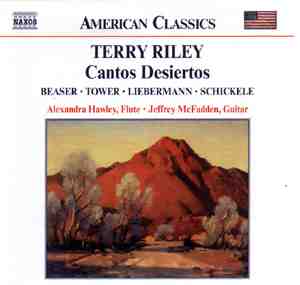 |
|
Terry Riley: Cantos Desiertos
Alexandra Hawley, Flute
Jeffrey McFadden, Guitar
Naxos 8.559146
|
|
0 |
5 |
|
Performance |
 |
|
Sonics |
 |
|
When a super-budget label eschews the tried and true
to issue the premiere recording of a work for flute/guitar duo by
California composer Terry Riley, the acknowledged “Father of Minimalism,”
it is time to take a listen. That the 25-minute Riley piece is framed by
four other attractive flute/guitar works, all by living American
composers, makes the disc essential listening for those drawn to this
instrumental combination.
Riley long ago progressed beyond his ‘60's period of
stoned-out repetitive minimalism to a more embracing, melodic style that
reflects 25 years of training and performance with North Indian classical
singer Pandit Pran Nath. Riley's long-time relationship with the
innovative Kronos Quartet, begun when he met violinist David Harrington
while teaching at Oakland's Mills College, has further expanded his
compositional palette. This diversity of influence – echt
California in its blending of the Far East with the post-psychedelic West
Coast avant garde – finds expression in the five flute and guitar pieces
that comprise Cantos Desiertos.
Cantos Desiertos
was commissioned by the Bay Area Avedis Chamber Music Series and guitarist
David Tannenbaum. While Tannenbaum is unfortunately absent from this
recording – he is most recently featured on Serenado
(New Albion), a delicious disc of guitar works by the late Lou Harrison
that includes Scenes from Nek Chand
written expressly for Tannenbaum and premiered by him at the 2002 Other
Minds Festival -- the Naxos performance is definitive by default because
the flutist, Avedis founder Alexandra Hawley, performed the premiere with
Tannenbaum at the California Palace of the Legion of Honor in San
Francisco.
The five Cantos Desiertos
are in turn part of the Book of
Abbeyozzud, a 26-piece work that
showcases the guitar either solo or in combination with other instruments.
Each piece has a Spanish title beginning with a different letter of the
alphabet. If this lends Cantos Desiertos
an inevitable Spanish flavor, the pieces also reflects Riley's love of
Indian music and jazz-like improvisation, and his unabashed pursuit of
joy.
Cantos Desiertos,
like many of Riley's works recently heard
at Berkeley's Edge Festival of California composers, is music that can
leave you cheering for more. The opening section, “Canción Desierto,” was
inspired by a dance-like melody Riley learned from his long time friend
and collaborator, Rajastani sitarist and composer Krishna Bhatt. The
movement bubbles along with great rhythmic freedom, only to metamorphose
into the subsequent “Quijote” (Dreamer). Things slow down temporarily with
“Llanto” (Lament), but pick up with “Tango Ladeado” (Tango Sideways). The
work ends with “Francesco in Paraiso” (Frank in Paradise), dedicated to
French composer and countertenor Royon le Mee, who died from AIDS at age
40. Lest this sound like a downer of an ending, the final movement began
as a piano and keyboard improvisation, while the preceding four works were
written during a sunny family sojourn to Puerto Vallarta.
Two of the other works on the disc, Robert Beaser's
likeable Mountain Songs and Lowell
Liebermann's Sonata were
variously commissioned by and dedicated to the flute/guitar duo of Paula
Robison and Eliot Fisk. Beaser's Mountain Songs, based largely on American
folk music melodies, is unfortunately short-changed in that only four of
the eight songs receive performances. Though Hawley and McFadden play
nicely, they pale beside the far more expressive duo of Susan Glaser and
Franco Platino, who offer the complete Mountain Songs
(Koch 3-7533-2 HI) on a 2002 release for which I wrote the liner notes.
Glaser/Platino play the beautiful opening “Barbara Allen” significantly
slower than their Naxos counterparts, rendering the song far more
evocative. On “The House Carpenter,” Platino's guitar is more incisive
than McFadden's, Glaser's flute more intense than Hawley's; only the Koch
team creates the unsettled feel that Beaser wishes us to experience. In
the final “Cindy,” Glaser rather than Hawley supplies the requisite swing,
with Platino's more closely recorded guitar more colorful than McFadden's.
The Naxos rendition is good enough to start your climb, but either Glaser/Platino
or Robison/Fisk will take you to the top of Beaser's oft-scaled opus.
New York City-born and Juilliard graduate Lowell
Liebermann counts among his teachers David Diamond. Liebermann was
nominated for the Prix Oscar Wilde by L'Association Oscar Wilde for his
opera, The Picture of Dorian Gray,
and received a Grammy nomination for his Piano Concerto No. 2,
Op. 36. Liebermann's two movement
Sonata for Flute and Guitar, Op. 25 proceeds from a dreamy Nocturne to a
highly energized, virtuosic gigue of an Allegro. Both performers rise to
the occasion.
[Those wishing to explore Liebermann's work will want
to experience the haunting mystery of his Sonata (1988) for flute and
piano. It is one of six works on American Flute Music
(Avie AV0004), a recital that pairs flutist Jeffrey Khaner with pianist
Hugh Sung. I hope to review this disc later on].
Joan Tower, recipient of the American Symphony
Orchestra League's first Made in America commission, contributes the
relatively short Snow Dreams.
Written for flutist Carol Wincenc and guitarist Sharon Isbin, the
intriguing piece becomes increasingly unsettled, metaphorically reflecting
the progression from light snowflakes to heavy snowfalls. The disc ends
with Peter Schickele's Windows: Three Pieces for Flute and
Guitar. While its conclusion gives
the instrumentalists a real workout, I prefer to hear Peter Schickele in
his other guise as P.D.Q. Bach. Regardless, for the other works on the
program – most certainly the Riley – this disc is more than worth the
asking price.

|
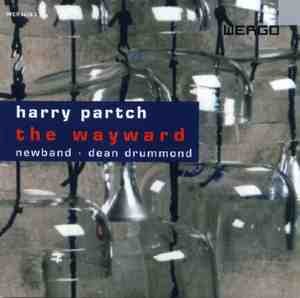 |
|
Harry Partch: The Wayward
Newband, Dean Drummond music director; Stephen Kalm, Baritone; Robert
Osborne, Bass-Baritone
Wergo WER 6638 2
|
|
0 |
5 |
|
Performance |
 |
|
Sonics |
 |
|
|
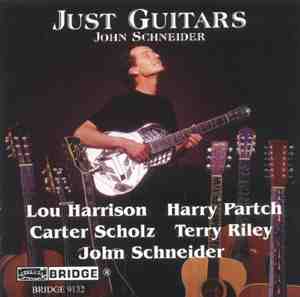 |
|
Just Guitars
John Schneider, Guitar and Vocals
Bridge 9132
|
|
0 |
5 |
|
Performance |
 |
|
Sonics |
 |
|
HARRY
PARTCH: 20TH CENTURY MUSICAL ICONOCLAST
"The individual's "path
cannot be retraced, for each of us is an original being."
-- Harry Partch
Harry Partch (1901-1974) was a true original: an
enigmatic American composer, musical theorist, philosopher, instrument
builder, hobo, and artist who left a body of work both provocative and
perplexing. Not only did he (like his friend composer Lou Harrison) eschew
traditional Western tunings to explore just tonality and microtonaltiy,
but he also created dozens of fantastic instruments, mammoth dance/theater
extravaganzas, and unique musical narratives based on everything from
Greek mythology to his own experiences as a hobo.
Although little is known of the first 40 years of
Partch's life – when Lou Harrison suggested to Partch that he write his
memoirs, Partch replied that many of his early memories, especially of his
childhood, were too difficult to face – what Partch did say about himself
he documented in his works Bitter Music,
End Littoral,
U.S. Highball; a rare interview with
Studs Terkel; and passages recalling his childhood in the preface to the
second edition of his book Genesis of a Music.
The Wergo recording features performances by the
ensemble Newband. Formed in 1978 to explore music using microtonality and
alternative tuning systems, Newband in 1990 received custodianship of the
collection of Partch's original instruments for which Partch composed most
of his work. The ensemble's conductor, Dean Drummond, is both director of
the Harry Partch Instrumentarium and Professor of Music at Montclair State
University.
The instruments, all tuned to just intonation,
include the Chromelodeon I, a pedal-pumped reed organ with sub-bass
adapted to play all the chromatic pitches in Partch's 43-tone per octave
source scale; the almost seven foot tall Kithara II, a hybrid harp/slide
guitar consisting of 72 vertical guitar strings arranged in twelve rows
each with six strings; and other such exotically named inventions as the
Harmonic Canon, Bloboy, Diamond Marimba, Bamboo Marimba, Bass Marimba,
Cloud Chamber Bowls, and Spoils of War. The latter is a collection of
percussion effects suspended from a sculptural stand that doubles as
resonator, named for the seven brass artillery casings that are tuned to
fit step-wide in the space of a semitone.
The 43-minute disc features four pieces collectively
known as The Wayward, which Partch
described as “a collection of musical compositions based on the spoken and
written words of hobos and other characters – the result of my wanderings
in the Western part of the United States 1935-1941.” Originally created
between 1941 and 1943 and extensively revised through 1967, the works
exist in various arrangements, the last for Partch's expanded collection
of original instruments. The Wayward
includes the famed eight hitchhiker transcriptions of Barstow,
the San Francisco cries of
two newsboys on a foggy night, The Letter
depression message from a hobo friend, and the US Highball
transcontinental hobo trip.
All feature text superimposed over the exotic sounds of Partch's
instruments, with just intonation microtunings that seem to arise from an
alternative sonic dimension.
Vocal soloists Stephen Kalm, baritone, and Robert
Osborne, bass-baritone, variously recite and sing Partch's words with an
authoritative, out-there hobo accent. Short of a recording featuring
Partch himself, this is about as definitive as you can get.
The Bridge disc features guitarist and vocalist
Schneider performing 78 minutes of works written for guitar tuned to just
intonation. In addition to first recordings of three vocal works by Partch
– Letter from Hobo Pablo, December 1942,
and Three Intrusions,
all which consist of arrangements by Partch played by Schneider on Adapted
Guitar and members of Just Strings on Kithara and Diamond Marimba, the
disc includes works by Carter Scholz, Lou Harrison, Terry Riley, and
Schneider himself. Though the claim that Harrison's Scenes from
Nek Chand for steel guitar is a first
recording seems opportunistic – Harrison wrote the work for guitarist
David Tannenbaum, who premiered it at San Francisco's 2002 Other Minds
Festival of New and Unusual Music and released what also claims to be the
first recording on Serenado
(New Albion NA 123) virtually a month
after the Bridge disc reached my hands – the very fact of competitive
recordings of one of the last works from Harrison's pen is cause for
celebration. Schneider's vocals on the Partch works pale beside those on
the Wergo disc, but that he gives us first recordings of Partch
arrangements for adapted guitar is cause for gratitude.
What does one make of Partch's
autobiographically-inspired work? You may either find yourself fascinated
and impelled to play it over and over, discover yourself submerged in
another dimension, or dismiss it with a shrug. But one thing is certain.
In an age of mind-numbing uniformity and predictable musical formulas,
with popular “hits” increasingly predicted by sophisticated computer
programming and political rhetoric that seems a doublespeak variation of
same, those with open minds owe it to themselves to explore Partch's
genre.
Bob Gilmore, Partch's first official biographer,
asserts that while the composer is often described as a self-taught
“natural genius,” he in fact studied twice for brief periods in the early
1920s at the University of Southern California, where he took piano
lessons with the then well-known pianist Olga Steeb, and later briefly
studied harmony and piano at the Kansas City Conservatory of Music. While
Partch spent a number of years traveling around the country as a hobo, his
composing was done either during breaks from this traumatic existence or
after he had settled down. The eight hitchhiker inscriptions from a
highway railing at Barstow, CA that comprise Barstow,
the only completed composition from his traumatic hobo years, was
written in a few weeks of relative
peace after Partch took a trip in early 1940 in a “search for my soul.”
U.S. Highball was composed
in a room in Ithaca, NY, when he was working at a bookkeeping job for a
"small scrap iron company" some eighteen months after the hobo trip it
describes. (For more information, see
http://www.corporeal.com/, the
website produced by Danlee Mitchell, Executive Director of the Harry
Partch Foundation).

|
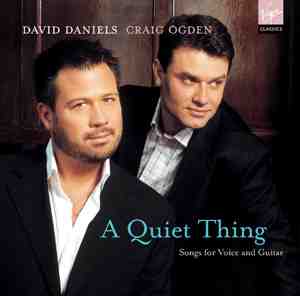 |
|
A Quiet Thing
David Danels, Countertenor; Craig Ogden, Guitar
Virgin Classics CDC 7243 5 45601 2
|
|
0 |
5 |
|
Performance |
 |
|
Sonics |
 |
|
Though he has built his unprecedented international
career as an countertenor on the rare technical assurance and emotional
truth he brings to the rapid coloratura fireworks of Handel, Vivaldi and
other baroque composers, David Daniels is equally prized for the honeyed,
round tones that distinguish his introverted, legato singing. Nowhere can
the beauty of his instrument and depth of his interpretations be
appreciated more than on his latest CD, whose 19 songs consistently eschew
showiness for intimacy..
In a phone interview conducted right after David had
returned from grueling Paris recording sessions of Berlioz's Les Nuits
d'été, he explained the genesis of
A Quiet Thing.
“From the beginning of my career, I've tried to open
up the doors of repertoire for my voice type, broadening ideas as to
what's possible for the countertenor voice. I had already recorded two or
three Handel recitals, a couple of oratorios, an opera, and a song recital
with piano; I wanted to do something different.
“Originally the disc was conceived to consist solely
of American songs, but we changed the idea because the Virgin label is
based in Paris. The American songs I was really passionate about were the
ones I included: the Alec Wilder song, and then “Beautiful Dreamer” and
“Shenandoah,” which I like especially well with guitar.
“It's really important for me to maintain a sense of
musical integrity. I wanted it to be a very intimate disc, accessible not
only to the people who are fans of mine but also to people who don't
necessarily come to opera and classical music. But it isn't just a
collection of easy listening classical songs; there's substance to it. I'm
not going to sing music that I can't bring something unique to.”
This critic heartily seconds Daniels' assessment.
John Kander's “A Quiet Thing,” which opens the recital, is an ideal
vehicle for David's honeyed tone. It also establishes the feeling of
relaxation and peace which deepens with the youthful freshness of Alec
Wilder's gorgeous “Blackberry Winter” and Leonard Bernstein's gentle “So
Pretty.”
The Bernstein, with lyrics by Betty Comden and Adolph
Green, consists of a dialogue between a child and his teacher. The child
questions the reasons we war against people far away, being told “they
must die for peace, you understand.” “But they're so pretty, so pretty”
responds the child. “I don't understand.”
While the song certainly strikes a chord, Daniels
explained that he chose it before the Iraq invasion scenario unfolded. “I
didn't have a political subtext in mind. I thought it was appropriate for
the boyish, white quality the countertenor voice can bring to it.”
Daniels next sings three Spanish songs from the 15th
and 16 centuries. The high tessitura of Francisco de la Torre's “Pampano
verde” especially benefits from the countertenor's soaring soulfulness; it
also displays his perfect legato. Ogden's well-recorded guitar punctuates
vocal phrases with an ideally artful smoothness. And Daniels' high note on
Gabriel Mena's “A la cara” is one to savor long after the performance has
concluded.
After familiar works by Dowland and Purcell, Daniels
sings three gorgeous Bellini songs. I must confess that I have often
considered the songs of Bellini and Donizetti inferior to their operatic
achievements. But with a singer of Daniels' (or Bartoli's) caliber, these
songs shine like gems.
I could have done without the treacle of Bernstein's
“A Simple Song,” and wish the Bach/Gounod “Ave Maria” were sung a half
step higher. But the simple beauty of Foster's “Beautiful Dreamer,” the
classic “Shenandoah,” and Martini's “Plaisir d'amour” provide a welcome
conclusion to a gorgeous disc.